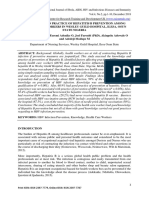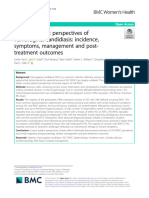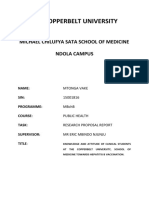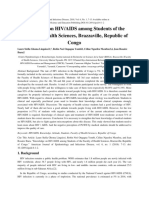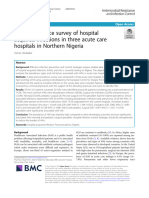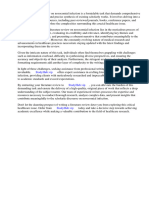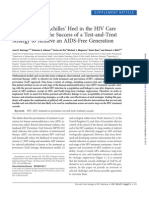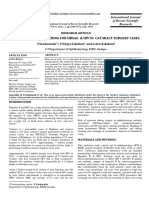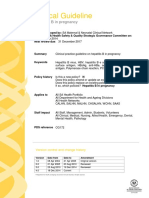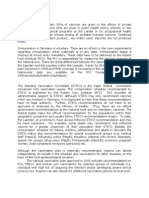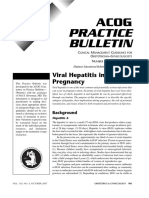Professional Documents
Culture Documents
Knowledge, Attitudes, and Practices (KAP) of Healthcare Workers On Viral Hepatitis B and Its Vaccination in 12 Health Establishments in The Centre Region of Cameroon
Original Title
Copyright
Available Formats
Share this document
Did you find this document useful?
Is this content inappropriate?
Report this DocumentCopyright:
Available Formats
Knowledge, Attitudes, and Practices (KAP) of Healthcare Workers On Viral Hepatitis B and Its Vaccination in 12 Health Establishments in The Centre Region of Cameroon
Copyright:
Available Formats
Volume 7, Issue 8, August – 2022 International Journal of Innovative Science and Research Technology
ISSN No:-2456-2165
Knowledge, Attitudes, and Practices (KAP) of
Healthcare Workers on Viral Hepatitis B and its
Vaccination in 12 Health Establishments in the Centre
Region of Cameroon
Justin Olivier Essindi1,2, Jacky Njiki Bikoï1, Donatien Serge Mbaga1, Etienne Atenguena Okobalemba3, Chris André Mbongue
Mikangue1, Alexandra Emmanuelle Membangbi1, Aicha Ngoutane1,4, Arnaud Franck Elang1, Sabine Aimée Touangnou-Chamda1,
Carole Stéphanie Sake1, George Ikomey Mondinde3,5, Sebastien Kenmoe6, Sara Honorine Riwom Essama1*
1-
Department of Microbiology, The University of Yaounde I, Yaounde, Cameroon
2-
Institut La Rosière Supérieure, Yaounde Cameroon
3-
Faculty of Medicine and Biomedical Sciences, The University of Yaounde I, Yaounde, Cameroon
4-
Institute of Medical Research and Medicinal Plant Study, Yaoundé, Cameroon
5-
Centre for the Study and Control of Communicable Diseases, Yaoundé, Cameroon
6-
Department of Microbiology and Parasitology, University of Buea, Buea, Cameroon,
*Corresponding author: Sara Honorine Riwom Essama, Department of Microbiology,
The University of Yaounde I, Yaounde, Cameroon PO Box 812 yaounde
Abstract:- Introduction: Viral hepatitis B (HBV) is a attitudes of the staff, as well as with the 3 questions
major public health issue around the globe. At 2020, the concerning the practice of vaccination, namely the storage
WHO estimated that 296 million people were carriers of temperature of the vaccines, the volume of the dose of
chronic viral hepatitis B. During the same year, the vaccine administered and the site of vaccine
number of deaths from cirrhosis and hepatocellular administration (p<0.05). Conclusion: The level of
carcinoma was 80%. In 2019, a total of 1.5 million new knowledge regarding the HBV pathway observed in this
infections were reported. HBV is most commonly study is satisfactory. Nevertheless, efforts still need to be
transmitted through contact with blood or other body redoubled on the attitude of the staff towards infected
fluids during sexual intercourse with an infected partner, patients, on taking the full doses of vaccine, and finally on
sharing needles, syringes, or preparation materials during the practice of vaccination, particularly on the storage
injection drug use, and puncturing with a hollow needle or temperature, the volume, and the administration site. This
contact with sharp objects. Cameroon is one of the worst lack of adequate knowledge may explain the often-
hit countries with an HBV prevalence of 11.5%. observed lack of post-vaccination response as knowledge is
Healthcare workers (HCWs) who are constantly exposed usually the first step toward modifying desirable behavior.
to a variety of body fluids are at increased risk of
contracting and transmitting the virus. It is thus important Keywords:- Vaccination, Hepatitis B, Knowledge, Attitude,
to evaluate their knowledge, attitudes and practices Practice, HCWs.
regarding HBV. Methodology: This cross-sectional study
took place from February to July 2022. In total, 388 HCWs I. INTRODUCTION
were recruited for the study. knowledge of HBV,
particularly the routes of transmission, attitudes toward Vaccination is one of the most beautiful examples of
HBV, and vaccination practices were evaluated using a human control environment, illustrating the ongoing struggle
well-structured questionnaire. Data analysis was against microorganisms. Preventing diseases is here, the
performed using SPSS V.25.0. Results: In total, 388 HCWs expression of human ingenuity anticipating the aggression of
participated in the study. The recommended pathways for pathogenic agents [1]. Hepatitis B virus (HBV) is an envelope
HBV transmission were sexual intercourse, soiled objects, virus in the Hepadnaviridae family that infects the liver,
blood transfusion and contact with contaminated blood causing hepatocellular necrosis and inflammation [2]. HBV is
(100%). Among the participants, 236 (60.8%) gave the transmitted through percutaneous or mucous membrane
correct answers on the signs of viral hepatitis B. exposure to infected blood and a variety of body fluids [3]. In
Knowledge was significantly associated with the number of 2020, the WHO estimated that 296 million people had
years spent in the vaccination service (p<0.0001). Overall, chronically HBV [4]. Currently available treatments fail to
these HCWs possessed a satisfactory level of knowledge of eradicate the virus in most people treated, requiring potentially
HBV transmission pathways (388, 100%). Of the 388 longlife treatment [5] when we know that about 820,000 people
HCWs, only 65 (16.8%) had a positive attitude towards die each year because of chronic hepatitis B (OMS, 2020).
those infected with HBV. Up to 87 (22.4%) gave incorrect Cameroon is one of the countries in sub-Saharan Africa, with
answers regarding the need to test the effectiveness of the an estimated 11.5% prevalence of HBV infection [6].
vaccine. There was a significant association between the Healthcare Workers (HCWs), who frequently come into
service, the category, the number of years of work, and the contact with blood and other body fluids in the course of their
IJISRT22AUG552 www.ijisrt.com 1522
Volume 7, Issue 8, August – 2022 International Journal of Innovative Science and Research Technology
ISSN No:-2456-2165
work, are exposed to blood-borne viral diseases such as HBV, B. Measured variables and statistical analyses
hepatitis C virus, and Human Immunodeficiency Virus [7,8]. HCWs who agreed to participate in the study completed a
HBV among HCWs (37%) is attributable to occupational structured questionnaire which was used to collect data on
exposure to lesions due to sharps [5]. The risk of occupational socio-demographic characteristics, knowledge of HBV
infections in developing countries is intensified by a variety of (particularly transmission), attitude towards HBV, and practice
factors, including overcrowding in hospitals, low staff-to- of vaccination against HBV. The information was given by the
patient ratios, insufficient or non-existent basic safety and Chief Medical Officer (if applicable), the General Supervisor,
protective equipment, reutilisation/reprocessing of and the Heads of Unit who were contacted respectively and
contaminated needles and sharp instruments, and partial asked to inform their staff of the study still in their respective
awareness of the risk of exposure to blood and body fluids [8]. establishment. An information notice was placed on the notice
Although seroconversion of hepatitis due to needle stick injury board of the hospital and hospital departments where available,
is quite rare, the costs of treatment and the anxiety associated to inform hospital staff of the study objectives and the timetable
with the possible consequences of exposure are severe [9]. That for its implementation. Finally, individual contacts were used
may be the reason why some HCWs refuse to serve patients to reach some staff. The questionnaire was completed in the
with blood-borne viral diseases, such as HBV [10]. Prevention presence of researcher to avoid participants sharing answers or
through immunization and improving knowledge, therefore, obtaining them online. Semi-structured, pre-designed, and pre-
appears to be the surest strategy against the high prevalence of test questionnaire items, with response options, have been
viral hepatitis among HCWs. Knowing the facts and adequate developed based on KAP (knowledge, attitudes, and practices)
awareness can influence the attitude of HCWs and control the with similar objectives [11, 14]. The questionnaire was
threat of disease [11]. Several studies in Africa have assessed validated according to the guidelines proposed by Jain et al in
the level of knowledge, attitude, and practice of HCWs vis-à- 2016 [14]. Knowledge of the route of HBV transmission was
vis HBV and their vaccination status [12]. The low level of assessed using five questions directly related to the route of
vaccination and the high prevalence of hepatitis B surface HBV infection. Knowledge was considered adequate when
antigen (HBsAg) recorded in different studies could be justified there were correct answers to all five questions. This minimum
by the low level of knowledge about HBV among HCWs [13]. of five correct answers to define a good level of knowledge may
Prevention remains a recommended guarantee against an seem rigorous. However, this minimum level justified the
epidemic of viral hepatitis. The knowledge and attitudes of reasonable difficulty of the questions. The attitude was
HCWs play a key role in preventing and spreading infection. assessed using the following criteria: attitude towards people
By Knowing the facts and having the appropriate awareness infected with HBV and HIV, frequency of glove use, frequency
and attitudes, the threat of this disease can be largely avoided. of needlestick injuries, and vaccination status. The attitude was
With that in mind, the objectives of this study are to assess the considered positive when a participant was able to give all
knowledge, attitudes, and practices of HCWs regarding HBV expected answers correctly, as HCWs are at the forefront of
in 12 health facilities in the Centre Region of Cameroon. health care delivery and should have an appropriate attitude
towards HBV. Vaccination practice was assessed using the
II. MATERIAL AND METHODES criteria vaccine storage temperature, volume of vaccine dose
administered, and site of administration. Information on
A. Type of study, setting, and population studied: vaccination knowledge, attitude, and practice were self-
This cross-sectional study was conducted among HCWs reported, and individual risk of bias cannot be completely ruled
from health structures in the Centre Region and those from the out. The variables collected were qualitative, recorded, and
international vaccination center in Yaounde, Cameroon. The processed in Excel. The analysis were performed using SPSS
samples were collected between February and July 2022 and V.25.0. Results were expressed as proportions and Pearson's χ2
included 12 health establishments in the Centre Region of (p<0.05) was used to assess the significance between study
Cameroon (one Centre hospital, three confessional hospitals, variables.
four district hospitals, one military hospital, one District
medical center, one private medical center and the international III. RESULTS
vaccination center). The participant sampling technique was
simple random. For each participant, the questionnaire was A. Sociodemographic parameters
self-administered and contained both closed and open In each health establishment, more than 50% of the
questions to assess respondents' knowledge, attitudes, and HCWs consented to participate in the study. These were
practices on HBV. HCWs that were present in the selected doctors, nurses, dentists, pharmacists, midwives, and
hospitals during the study period were informed and invited to laboratory technicians. A total of 388 HCWs participated in the
participate in the study. These were doctors, nurses, dentists, study. Among them, 287/388 (74%) were women. The age
pharmacists, midwives, and laboratory technicians. group (37-41 years) was the most represented 203/388 (52.3%).
Most participants were nurses 179/388 (46.1%) followed by
doctors 160/388 (41.2%). The number of years spent in the
service between (6-8 years) was the most represented 139/388
(35.8%) (Table 1).
IJISRT22AUG552 www.ijisrt.com 1523
Volume 7, Issue 8, August – 2022 International Journal of Innovative Science and Research Technology
ISSN No:-2456-2165
Table 1: Sociodemographic parameters of participants
Variable Number Percentage
(N=388)
Sex Feminine 287 74.0
Male 101 26.0
27-31 21 5.4
Grouped age 32-36 48 12.4
37-41 203 52.3
42-46 116 29.9
Study level High 388 100.0
Welcome 21 5.4
Surgery 20 5.2
Gynecology 20 5.2
Service Laboratory 30 7.7
Maternity 65 16.8
Medicine 110 28.4
Pediatrics 38 9.8
Vaccination 84 21.6
Male nurse 179 46.1
Occupation Doctor 160 41.2
Midwife 19 4.9
Laboratory 30 7.7
technician
Status Contractual 275 70.9
individual 113 29.1
[3-5] 104 26.8
Number of years [6-8] 139 35.8
spent in service ≤2 48 12.4
≥9 97 25.0
No 181 46.6
Immunization Yes 207 53.4
activities
HBV vaccination No 181 46.6
activities
Yes 207 53.4
B. Knowledge about HBV transmission
A questionnaire comprising five questions was used to assess the knowledge of the staff of the various hospitals on the routes
of transmission of HBV and those recommended were sexual intercourse, soiled objects, blood transfusion, and contact with
contaminated blood 388/ 388 (100%), this corresponded to a satisfactory level of knowledge on the transmission routes of HBV
(table 2)
Table 2: Knowledge about HBV transmission
Percentage of the correct answer (%)
Nurse Doctor Midwife Laboratory
technician Overall
Questions (n=179) (n=160) (n=19) (n=30) (N=388)
About sex Yes 179 (100.0) 160 (100.0) 19 (100.0) 30 (100.0) 388(100.0)
By soiled objects Yes 179(100.0) 160 (100.0) 19 (100.0) 30 (100.0) 388 (100.0)
By blood transfusion Yes 179 (100.0) 160 (100.0) 19 (100.0) 30 (100.0) 388 (100.0)
By contact with Yes 179 (100.0) 160 (100.0) 19 (100.0) 30 (100.0) 388 (100.0)
contaminated blood
By physical contact No 130 (72.6) 117 (73.1) 19 (100.0) 10 (33.3) 276 (71.1)
Yes 49 (27.4) 43 (26.9) // 20 (66.7) 112 (28.9)
Modes of transmission Right 179 (100.0) 160 (100.0) 19 (100.0) 30 (100.0) 388(100.0)
answer
IJISRT22AUG552 www.ijisrt.com 1524
Volume 7, Issue 8, August – 2022 International Journal of Innovative Science and Research Technology
ISSN No:-2456-2165
C. Knowledge of the signs, complications, methods of prevention, and fear of HBV
Among participants, 236/388 (60.8%) gave good answers on the signs of viral hepatitis B. All of the participants mastered the
knowledge of the complications of hepatitis B 388/388 (100%). The staff that were afraid of the disease was 277/388 (71.4%) while
the prevention methods were known to all 388/388 (100%). The doctors were the best informed about the signs of HBV 120/388
(75%) and all the midwives 19/19 (100%) were afraid of illness followed by nurses 132/179 (73.7%) (Table 3).
Table 3: knowledge of the signs, complications, methods of prevention, and fear of HBV
Answer (%)
nurse Doctor Midwife Laboratory
technician
(n=179) (n=160) (n=19) Total
(n=30) (N=388)
Signs of Right 116 (64.8) 120 (75.0) // // 236 (60.8)
Hepatitis B answer
Wrong 42 (23.5) // // // 42 (10.8)
answer
Insufficient 21 (11.7) 40 (25.0) 19 (100.0) 30 (100.0) 110 (28.4)
response
Knowledge of Right 179 (100.0) 160 (100.0) 19 (100.0) 30 (100.0) 388 (100.0)
hepatitis B answer
complications
The different Right 179 (100.0) 160 (100.0) 19 (100.0) 30 (100.0) 388 (100.0)
methods of answer
prevention
No 47 (26.3) 54 (33.8) // 10 (33.3) 111 (28.6)
Fear of disease Yes 132 (73.7) 106 (66.3) 19 (100.0) 20 (66.7) 277 (71.4)
D. General knowledge of vaccination, staff attitudes, and frequency of correct answers on the practice of vaccination against HBV
Among the 388 HCWs, only 65 (16.8%) had good attitude towards people infected with HBV (Table 4). There was a significant
association between the service, the category, the number of years of work, and the attitudes of the staff, as well as with the 3 questions
concerning the practice of vaccination, namely the storage temperature of the vaccines, the volume of the dose of vaccine administered
and the site of vaccine administration (p<0.05) (Table 5). Nurses had the highest frequency of correct answers 157/179 (87.7%) while
55/160 (34.4%) of doctors had the highest frequency of wrong answers (Table 6).
IJISRT22AUG552 www.ijisrt.com 1525
Volume 7, Issue 8, August – 2022 International Journal of Innovative Science and Research Technology
ISSN No:-2456-2165
Table 4: General knowledge about vaccination
Answer (%)
Nurse Doctor Midwife Laboratory
(n=179) (n=160) (n=19) technician Overall
(n=30) (N=388)
No 56(31.3) // // 10(33.3) 66(17.0)
Be Yes 123(68.7) 160 (100.0) 19(100.0) 20(66.7) 322(83.0)
vaccinated
Complete No 56(31.3) 41 (25.6) // 10(33.3) 107 (27.6)
vaccination Yes 123(68.7) 119 (74.4) 19(100.0) 20(66.7) 281 (72.4)
Complete Yes // 41 (25.6) // // 41 (10.6)
your vaccine No answers 179(100.0) 119 (74.4) 19(100.0) 30(100.0) 347 (89.4)
Preferred Right 179(100.0) 160 (100.0) 19(100.0) 30(100.0) 388 (100.0)
vaccination answer
schedule
Right 153(85.5) 139 (86.9) 19(100.0) 30(100.0) 341 (87.9)
Vaccine answer
storage Insufficient 26(14.5) 21 (13.1) // // 47 (12.1)
response
temperature
Administratio Right 158(88.3) 126 (78.8) 19(100.0) 30(100.0) 333 (85.8)
n site answer
Wrong 21(11.7) 34 (21.3) // // 55 (14.2)
answer
Vaccine dose Right 123(68.7) 139 (86.9) 19(100.0) 20(66.7) 301 (77.6)
volume answer
Wrong 56(31.3) 21 (13.1) // 10(33.3) 87 (22.4)
answer
Right answer // // // 10(33.3) 10 (2.6)
Knowledge of Insufficient 179(100.0) 160(100.0) 19(100.0) 20(66.7) 378 (97.4)
names of response
HVB vaccines
Right answer 156(87.2) 133 (83.1) 19(100.0) 20(66.7) 328 (84.5)
Most used Insufficient 23(12.8) 27 (16.9) // 10(33.3) 60 (15.5)
vaccine response
The rationale Right answer 23(12.8) 27 (16.9) // 10 (33.3) 60 (15.5)
for most used
vaccine Insufficient 156(87.2) 133 (83.1) 19(100.0) 20(66.7) 328 (84.5)
response
Requires Right answer 133(74.3) 119 (74.4) 19(100.0) 30(100.0) 301 (77.6)
verification of
vaccine Wrong 46(25.7) 41 (25.6) // // 87 (22.4)
answer
efficacy
Vaccination Right answer 179(100.0) 133 (83.1) 19(100.0) 30(100.0) 361 (93.0)
of HIV+ Wrong // 27 (16.9) // // 27 (7.0)
answer
What to do in Right answer 179(100.0) 160 (100.0) 19(100.0) 30(100.0) 388 (100.0)
case of side
effects
Attitudes Right answer 45(25.1) 20 (12.5) // // 65 (16.8)
towards
Wrong 134(74.9) 140 (87.5) 19(100.0) 30(100.0) 323 (83.2)
infected answer
patients
Wearing Right answer 179(100.0) 160 (100.0) 19(100.0) 30(100.0) 388 (100.0)
gloves
Needle prick No 159(88.8) 160 (100.0) 19(100.0) 30(100.0) 368 (94.8)
Yes 20(11.2) // // // 20(5.2)
IJISRT22AUG552 www.ijisrt.com 1526
Volume 7, Issue 8, August – 2022 International Journal of Innovative Science and Research Technology
ISSN No:-2456-2165
Table 5: General distribution of responses on the practice of vaccination
Vaccine storage p p Vaccine dose p
Administration
temperature volume
site n(%)
n(%)
n(%)
Service Welcome 21 (5.4) 21 (5.4) 21 (5.4)
Surgery 20 (5.2) 20 (5.2) 20 (5.2)
Gynecology 20 (5.2) 20 (5.2) 20 (5.2)
Laboratory 30 (7.7) < 0.0001 30 (7.7) < 0.0001 30 (7.7) < 0.0001
Maternity 65 (16.8) 65 (16.8) 65 (16.8)
Medicine 110 (28.4) 110 (28.4) 110 (28.4)
Pediatrics 38 (9.8) 38 (9.8) 38 (9.8)
Vaccination 84 (21.6) 84 (21.6) 84 (21.6)
State nurse 179 (46.1) 179 (46.1) 0.048 179 (46.1)
Doctor 160 (41.2) 0.048 160 (41.2) 160 (41.2) 0.048
Category of HCWs
Midwife 19 (4.9) 19 (4.9) 19 (4.9)
Laboratory 30 (7.7) 30 (7.7) 30 (7.7)
technician
Number of years spent in [3-5] 104 (26.8) < 0.0001 104 (26.8) < 0.0001 104 (26.8) < 0.0001
the vaccination service [6-8] 139 (35.8) 139 (35.8) 139 (35.8)
≤2 48 (12.4) 48 (12.4) 48 (12.4)
≥9 97 (25.0) 97 (25.0) 97 (25.0)
HBV vaccination activity Nope 181 (46.6) 0.008 181 (46.6) 0.008 181 (46.6) 0.008
Yes 207 (53.4) 207 (53.4) 207 (53.4)
Healthcare Workers: HCWs
Table 6: Frequency of correct answers on the practice of vaccination concerning the storage
temperature, the volume of the dose administered, and the site of administration.
Correct Wrong
Variables P-value
answer n(%) answer n(%)
Welcome 10 (47.6) 11 (52.4)
Surgery 20 (100.0) 0(0,0)
Gynecology 20 (100.0) 0(0,0)
Service Laboratory 20 (66.7) 10 (33.3) < 0.0001
Maternity 46 (40.0) 69 (60.0)
Medicine 75 (68.2) 35 (31.8)
Pediatrics 17 (44.7) 21 (55.3)
Vaccination 93 (83.8) 18 (16.2)
State nurse 157 (87.7) 22 (12.3)
Doctor 105 (65.6) 55 (34.4)
Category of HCWs Midwife 19 (100.0) 0 (0.0) 0.008
Laboratory 20 (66.7) 10 (33.3)
technician
Number of years spent [3-5] 87 (66.4) 44 (33.6)
in the vaccination [6-8] 129 (77.7) 37 (22.3) < 0.0001
service ≤2 27 (56.3) 21 (43.8)
≥9 58 (48.3) 62 (51.7)
Immunization activity No 125 (69.1) 56 (30.9) 0.119
Yes 176 (62.0) 108 (38.0)
HBV vaccination No 125 (69.1) 56 (30.9)
activity Yes 176 (62.0) 108 (38.0) 0.119
Healthcare Workers: HCWs
IJISRT22AUG552 www.ijisrt.com 1527
Volume 7, Issue 8, August – 2022 International Journal of Innovative Science and Research Technology
ISSN No:-2456-2165
IV. DISCUSSION CONFLICTS OF INTEREST
The authors declare no conflict of interest
The level of knowledge on HBV transmission routes was
satisfactory (100%). Among the 388 HCWs, only 65 (16.8%) AUTHORS CONTRIBUTIONS
had good attitude towards people infected with HBV. There All authors contributed to this work. They read and
was a significant association between the service, the category, approved the final version of the manuscript
and the number of years of work of the staff, as well as with the
3 questions concerning the practice of vaccination, namely the ACKNOWLEDGMENT
storage temperature of the vaccines, the volume of the dose of
vaccine administered and site of vaccine administration The authors thank all the Healthcare Workers for their
(p<0.05). participation in the study. Our thanks also go to the
administrative and health authorities of the various structures
HCWs are at the forefront of HCWs delivery and are to have allowed access to their site and the smooth running of
expected to know the transmission routes of different infectious the study
agents to protect themselves and their patients from nosocomial
infections. The results of the current study revealed a REFERENCES
significant association between the service, the category, the
number of years of work of the HCWs, and knowledge about [1]. Abeje G and Azage M 2015 Hepatitis B vaccine
HBV. This is similar to what was obtained in the North West knowledge and vaccination status among health care
region of Cameroon and North East Ethiopia [2, 3, 9]. This can workers of Bahir Dar City Administration, Northwest
be justified by the fact that the category of nurse and doctor Ethiopia: a cross sectional study BMC Infectious
does not have the same level of education because the latter Diseases 15 30
trains individuals to acquire, evaluate and use information. This [2]. Ngekeng S, Mefire A, Fon P, Nsagha D S, Nkuigue A,
can justify the unequal access to and use of educational Tiogouo K, Oben F, Ekotang P and Choukem S P 2018
resources, which increase with the level of education [13] as Hepatitis B Prevalence, Knowledge and Occupational
well as the role in the health environment. Similarly, staffs Factors among Health Care Workers in Fako Division,
already working in vaccination services have more knowledge South West Region Cameroon Microbiology Research
of vaccination compared to those working in other services. All Journal International 23 1–9
the HCWs of the different structures 388 (100%) had a good [3]. Akazong W E, Tume C, Njouom R, Ayong L, Fondoh V
knowledge of the transmission route of HBV. This figure does and Kuiate J-R 2020 Knowledge, attitude and prevalence
not corroborate that found in the South West Region of of hepatitis B virus among healthcare workers: a cross-
Cameroon (58.7%) [2]and that found in Tanzania (62.5%) [15]. sectional, hospital-based study in Bamenda Health
This difference could be explained by the fact that all our District, NWR, Cameroon BMJ Open 10 e031075
participants had a level of study higher than 388 (100%). The [4]. WHO 2015 Guidelines for the prevention, care and
result obtained by our study on the knowledge of the route of treatment of persons with chronic hepatitis B infection
transmission is much higher than that found in the North-West [5]. WHO 2017 Fact Sheet: Hepatitis B in the WHO
of Ethiopia (52%) [1], Sierra Leone (29.9%) (14), and in rural European Region 2
population of the North West Region of Cameroon (42.1%) [6]. Njouom R, Tejiokem M, Texier G and Fontanet A 2015
[13]. The most likely reason for the results found in the latter Prevalence of hepatitis B, hepatitis C and hepatitis D
could be inadequate health education programs, requiring staff virus infections in Cameroon: results from a national
to learn about HBV from friends and/or colleagues, which population based survey (The ANRS 12289 project) vol
increases the likelihood of obtaining inappropriate information 22
[16]. [7]. Tarantola A, Abiteboul D and Rachline A 2006 Infection
risks following accidental exposure to blood or body
In addition to what is already known on the knowledge, fluids in health care workers: a review of pathogens
attitudes, and practice of HCWs on HBV, our study provides transmitted in published cases Am J Infect Control 34
new information on the vaccination practice, in particular, the 367–75
control of the storage temperature, the volume of the dose, the [8]. Elmukashfi T, Balla S, Abdalla A, Elawad M,
administration site and finally the administration or not to Swareldahab Z and Bashir A 2016 Knowledge, Attitude
HIV+ patients. and Practice of Heath Care Workers Regarding
Transmission and Prevention of Hepatitis B Virus
V. CONCLUSION Infection, White Nile State, Sudan, 2013 American
Journal of Health Research 4
The level of knowledge of the HBV transmission route [9]. Demsiss W, Seid A and Fiseha T 2018 Hepatitis B and
observed in this study is satisfactory. However, efforts still C: Seroprevalence, knowledge, practice and associated
need to be made on the attitude of the staff towards infected factors among medicine and health science students in
patients, on the complete taking of the vaccine doses and finally Northeast Ethiopia PLOS ONE 13 e0196539
on the practice of vaccination, notably on the storage [10]. Qin Y-L, Li B, Zhou Y-S, Zhang X, Li L, Song B, Liu P,
temperature, the volume and the site of administration. This Yuan Y, Zhao Z-P, Jiao J, Li J, Sun Y, Sevalie S, Kanu J
lack of adequate knowledge could explain the absence of post- E, Song Y-J, Jiang J-F, Sahr F, Jiang T-J, Qin Y-L, Li B,
vaccination reactions often observed. Yuan Y, Sun Y, Li J, Zhao Z-P, Jiao J, Song Y-J, Jiang
IJISRT22AUG552 www.ijisrt.com 1528
Volume 7, Issue 8, August – 2022 International Journal of Innovative Science and Research Technology
ISSN No:-2456-2165
T-J, Jiang J-F, and Chinese Military Medical Experts
Group in Sierra Leone 2018 Prevalence and associated
knowledge of hepatitis B infection among healthcare
workers in Freetown, Sierra Leone BMC Infectious
Diseases 18 315
[11]. Tandi T E, Cho Y, Akam A J-C, Afoh C O, Ryu S H,
Choi M S, Kim K and Choi J W 2015 Cameroon public
health sector: shortage and inequalities in geographic
distribution of health personnel Int J Equity Health 14 43
[12]. Zimmerman E and Woolf S H 2014 Understanding the
Relationship Between Education and Health NAM
Perspectives 4
[13]. Abongwa L E, Sunjo N S and Afah N G 2016
Assessment of Knowledge, Attitude and Practice
towards Hepatitis B among two rural communities of the
Anglophone regions in Cameroon IRA-International
Journal of Applied Sciences (ISSN 2455-4499) 4 490–
505
[14]. Jain S, Dubey S and Jain S 2016 Designing and
validation of questionnaire IDJAR 2 1` – 3
[15]. Shao E R, Mboya I B, Gunda D W, Ruhangisa F G, Temu
E M, Nkwama M L, Pyuza J J, Kilonzo K G, Lyamuya F
S and Maro V P 2018 Seroprevalence of hepatitis B virus
infection and associated factors among healthcare
workers in northern Tanzania BMC Infectious Diseases
18 474
[16]. Al-Thaqafy M S, Balkhy H H, Memish Z, Makhdom Y
M, Ibrahim A, Al-Amri A and Al-Thaqafi A 2012
Improvement of the low knowledge, attitude and practice
of hepatitis B virus infection among Saudi national guard
personnel after educational intervention BMC Res Notes
5 597
IJISRT22AUG552 www.ijisrt.com 1529
You might also like
- Hepatitis B Virus and Liver DiseaseFrom EverandHepatitis B Virus and Liver DiseaseJia-Horng KaoNo ratings yet
- Knowledge, Attitude and Practices About Prevention of Transmission Hepatitis B Virus Among Nursing Students On Ward Placement at KIU Teaching Hospital.Document16 pagesKnowledge, Attitude and Practices About Prevention of Transmission Hepatitis B Virus Among Nursing Students On Ward Placement at KIU Teaching Hospital.KIU PUBLICATION AND EXTENSIONNo ratings yet
- Kenya High Risk GroupsDocument8 pagesKenya High Risk GroupsjackleenNo ratings yet
- Journal Pone 0276730Document14 pagesJournal Pone 0276730Suryadi LimardiNo ratings yet
- Knowledge, Attitude, Practice and Perceived Barriers - SaqlainDocument6 pagesKnowledge, Attitude, Practice and Perceived Barriers - SaqlainGaby CacñahuarayNo ratings yet
- Knowledge and Practice of Hepatitis B Prevention Among Health Care Workers in Wesley Guild HospitDocument10 pagesKnowledge and Practice of Hepatitis B Prevention Among Health Care Workers in Wesley Guild HospitFrancis OpwonyaNo ratings yet
- Chapter 1Document32 pagesChapter 1Robee Camille Desabelle-SumatraNo ratings yet
- Hepatitis B Knowledge and Preventive Practices Amongst Medical Students in A Tertiary Institution in Abia State, South-East NigeriaDocument8 pagesHepatitis B Knowledge and Preventive Practices Amongst Medical Students in A Tertiary Institution in Abia State, South-East NigeriaIJAR JOURNALNo ratings yet
- Researcharticle Open Access: Tigist EngdaDocument12 pagesResearcharticle Open Access: Tigist EngdasitiNo ratings yet
- Knowledge Attitude Practice and Perceived Barriers Among Healthcare Workers Regarding COVID-19 A Cross Sectional Survey From PakistanDocument5 pagesKnowledge Attitude Practice and Perceived Barriers Among Healthcare Workers Regarding COVID-19 A Cross Sectional Survey From PakistanRaphaelNo ratings yet
- 2019 Article 748Document9 pages2019 Article 748Endy SitumbekoNo ratings yet
- HBAg EngDocument19 pagesHBAg EngRodrigue GouajeuNo ratings yet
- Literature Review of Hepatitis B Virus InfectionDocument4 pagesLiterature Review of Hepatitis B Virus Infectionbsdavcvkg100% (1)
- JPAM Vol 14 Issue1 P 609-614Document6 pagesJPAM Vol 14 Issue1 P 609-614Tira Alfiani LaariyaNo ratings yet
- Factors Associated With Low Hepatitis B Vaccination Turn-Up Among Students at KIU-WC Bushenyi DistrictDocument8 pagesFactors Associated With Low Hepatitis B Vaccination Turn-Up Among Students at KIU-WC Bushenyi DistrictKIU PUBLICATION AND EXTENSIONNo ratings yet
- Jof 06 00216 v2Document18 pagesJof 06 00216 v2Grace Yuni Soesanti MhNo ratings yet
- Vake's Proposal On HepatitisDocument26 pagesVake's Proposal On HepatitisVake MtongaNo ratings yet
- SC 6Document4 pagesSC 6khamilatusyNo ratings yet
- Novel Coronavirus COVID-19 Knowledge and PerceptioDocument16 pagesNovel Coronavirus COVID-19 Knowledge and Perceptiotiglu nanoNo ratings yet
- International Journal of Infectious Diseases: SciencedirectDocument5 pagesInternational Journal of Infectious Diseases: SciencedirectMuh Syukriadi AnsarNo ratings yet
- Awareness and Attitude of Undergraduate Medical Students Towards 2019-Novel Coronavirus in A Local Pakistani Medical CollegeDocument13 pagesAwareness and Attitude of Undergraduate Medical Students Towards 2019-Novel Coronavirus in A Local Pakistani Medical CollegeImtiaz BashirNo ratings yet
- Prevalence and Risk Factors Associated With Chronic Hepatitis B Among Patients Attending Fort Portal Regional Referral Hospital in Kabarole District, Western UgandaDocument13 pagesPrevalence and Risk Factors Associated With Chronic Hepatitis B Among Patients Attending Fort Portal Regional Referral Hospital in Kabarole District, Western UgandaKIU PUBLICATION AND EXTENSIONNo ratings yet
- Knowledge On HIV/AIDS Among Students of The Faculty of Health Sciences, Brazzaville, Republic of CongoDocument14 pagesKnowledge On HIV/AIDS Among Students of The Faculty of Health Sciences, Brazzaville, Republic of CongoNovita HerlitadewiNo ratings yet
- COVID-19 Testing: A Reflection On Test Accuracy in The Real WorldDocument34 pagesCOVID-19 Testing: A Reflection On Test Accuracy in The Real Worldjoeboots78No ratings yet
- 2020 Article 722Document7 pages2020 Article 722Grâce KabengeleNo ratings yet
- Risk Factors For Viral Hepatitis A Infection in Gampaha District, Sri Lanka: An Unmatched Case Control StudyDocument7 pagesRisk Factors For Viral Hepatitis A Infection in Gampaha District, Sri Lanka: An Unmatched Case Control StudyANANTHA PRAKASH VEESAMNo ratings yet
- MainDocument16 pagesMainrosarioaliaga2609No ratings yet
- Pathogens 11 01248Document13 pagesPathogens 11 01248Ngọc Minh Anh NguyễnNo ratings yet
- Ambo UniversityDocument12 pagesAmbo UniversityArarsa TolasaNo ratings yet
- 18586-Article Text-77701-1-10-20190219Document15 pages18586-Article Text-77701-1-10-20190219AyitenewNo ratings yet
- Nosocomial Infections: Knowledge and Source of Information Among Clinical Health Care Students in GhanaDocument10 pagesNosocomial Infections: Knowledge and Source of Information Among Clinical Health Care Students in GhanaarreyemilieneNo ratings yet
- Healthcare: A Systematic Review of Healthcare-Associated Infectious Organisms in Medical Radiation Science DepartmentsDocument14 pagesHealthcare: A Systematic Review of Healthcare-Associated Infectious Organisms in Medical Radiation Science DepartmentsArina Al-KhaqNo ratings yet
- Vaccination Status Knowledge and Awareness Towards Hepatitis B Among Students of Health ProfessionDocument9 pagesVaccination Status Knowledge and Awareness Towards Hepatitis B Among Students of Health ProfessionMark jay LlanoNo ratings yet
- s12879 021 06459 ZDocument11 pagess12879 021 06459 ZCliff Daniel DIANZOLE MOUNKANANo ratings yet
- Tugineyo Immaculate Faculty of Clinical Medicine and Dentistry Kampala International University Western Campus UgandaDocument15 pagesTugineyo Immaculate Faculty of Clinical Medicine and Dentistry Kampala International University Western Campus UgandaKIU PUBLICATION AND EXTENSIONNo ratings yet
- Ijcmph-10733 oDocument6 pagesIjcmph-10733 oJamooooonNo ratings yet
- 11) Jurnal LR Full (Bhagavathula)Document15 pages11) Jurnal LR Full (Bhagavathula)Mastifa HanasitaNo ratings yet
- Influenza Vaccination: Healthcare Workers Attitude in Three Middle East CountriesDocument7 pagesInfluenza Vaccination: Healthcare Workers Attitude in Three Middle East CountriesDesti EryaniNo ratings yet
- Hospital Acquired Infection Incidence and Risk FactorsDocument7 pagesHospital Acquired Infection Incidence and Risk FactorsKshitiz112No ratings yet
- Literature Review On Nosocomial InfectionDocument5 pagesLiterature Review On Nosocomial Infectioneowcnerke100% (1)
- Interprofessional CollaboratioDocument16 pagesInterprofessional CollaboratioAnggito AbimanyuNo ratings yet
- Artigo Sobre AidsDocument7 pagesArtigo Sobre AidscamilatututNo ratings yet
- Falla InmunologicaDocument10 pagesFalla InmunologicaAlejandra OrtizNo ratings yet
- Journal of Viral Hepatitis - 2021 - Dzingirai - Progress On The Elimination of Viral Hepatitis in Zimbabwe A Review of TheDocument9 pagesJournal of Viral Hepatitis - 2021 - Dzingirai - Progress On The Elimination of Viral Hepatitis in Zimbabwe A Review of TheinyashaNo ratings yet
- Comparison of Antiretroviral Therapy Adherence Among HIV Infected Older Adults With Younger Adults in Africa: Systematic Review and Meta AnalysisDocument14 pagesComparison of Antiretroviral Therapy Adherence Among HIV Infected Older Adults With Younger Adults in Africa: Systematic Review and Meta AnalysisCliff Daniel DIANZOLE MOUNKANANo ratings yet
- Novas Diretrizes Hepatite BDocument18 pagesNovas Diretrizes Hepatite BJess jourNo ratings yet
- The HIV Care Continuum and HIV-1 Drug Resistance Among Female Sex Workers: A Key Population in Guinea-BissauDocument11 pagesThe HIV Care Continuum and HIV-1 Drug Resistance Among Female Sex Workers: A Key Population in Guinea-Bissautomasarino74No ratings yet
- Awareness, Knowledge, and Practice For Hepatitis B Infection in Southeast Asia: A Cross-Sectional StudyDocument15 pagesAwareness, Knowledge, and Practice For Hepatitis B Infection in Southeast Asia: A Cross-Sectional StudyAhamed AbdalmajidNo ratings yet
- Acceptance of A COVID19 Vaccine in Southeast Asia A CrossSectional Study in IndonesiaDocument8 pagesAcceptance of A COVID19 Vaccine in Southeast Asia A CrossSectional Study in IndonesiaAntonio MoncayoNo ratings yet
- Recent Advances in The Development and Evaluation of Molecular Diagnostics For Evola Virus DiseaseDocument30 pagesRecent Advances in The Development and Evaluation of Molecular Diagnostics For Evola Virus DiseaseWendi IochNo ratings yet
- Hepatitis B Vaccination Status Among Students of A Medical CollegeDocument5 pagesHepatitis B Vaccination Status Among Students of A Medical CollegeDr. Imran Mahmood KhanNo ratings yet
- Acceptance of COVID-19 Vaccination During The COVID-19 Pandemic in ChinaDocument14 pagesAcceptance of COVID-19 Vaccination During The COVID-19 Pandemic in ChinaMark Nel NuñezNo ratings yet
- Risk Factors for Hepatitis B in Northern PakistanDocument3 pagesRisk Factors for Hepatitis B in Northern PakistanDr Alamzeb JadoonNo ratings yet
- Antibiotico CovidDocument12 pagesAntibiotico CovidPaul ArtigasNo ratings yet
- Isoniazid Prophylaxis Highly Effective But UnderutDocument2 pagesIsoniazid Prophylaxis Highly Effective But Underutemilianoarteagagarcia11No ratings yet
- The Worldwide Impact of Vaccination On The Control and Protection of Viral Hepatitis BDocument6 pagesThe Worldwide Impact of Vaccination On The Control and Protection of Viral Hepatitis BYle BravoNo ratings yet
- Bacterial Co-Infection and Secondary Infection in Patients With COVID19 A Living Rapid Review and Meta-AnalysisDocument8 pagesBacterial Co-Infection and Secondary Infection in Patients With COVID19 A Living Rapid Review and Meta-AnalysisSundas EjazNo ratings yet
- 1 s2.0 S0264410X1930163X MainDocument7 pages1 s2.0 S0264410X1930163X Mainzezo.3kxNo ratings yet
- Acceptance and Attitudes Toward COVID-19 Vaccines: A Cross-Sectional Study From JordanDocument15 pagesAcceptance and Attitudes Toward COVID-19 Vaccines: A Cross-Sectional Study From JordanAmira SekrettNo ratings yet
- 2953 Hbsag SkriningDocument4 pages2953 Hbsag Skriningursula 002No ratings yet
- Automatic Power Factor ControllerDocument4 pagesAutomatic Power Factor ControllerInternational Journal of Innovative Science and Research TechnologyNo ratings yet
- A Review: Pink Eye Outbreak in IndiaDocument3 pagesA Review: Pink Eye Outbreak in IndiaInternational Journal of Innovative Science and Research TechnologyNo ratings yet
- Studying the Situation and Proposing Some Basic Solutions to Improve Psychological Harmony Between Managerial Staff and Students of Medical Universities in Hanoi AreaDocument5 pagesStudying the Situation and Proposing Some Basic Solutions to Improve Psychological Harmony Between Managerial Staff and Students of Medical Universities in Hanoi AreaInternational Journal of Innovative Science and Research TechnologyNo ratings yet
- Navigating Digitalization: AHP Insights for SMEs' Strategic TransformationDocument11 pagesNavigating Digitalization: AHP Insights for SMEs' Strategic TransformationInternational Journal of Innovative Science and Research TechnologyNo ratings yet
- Mobile Distractions among Adolescents: Impact on Learning in the Aftermath of COVID-19 in IndiaDocument2 pagesMobile Distractions among Adolescents: Impact on Learning in the Aftermath of COVID-19 in IndiaInternational Journal of Innovative Science and Research TechnologyNo ratings yet
- Perceived Impact of Active Pedagogy in Medical Students' Learning at the Faculty of Medicine and Pharmacy of CasablancaDocument5 pagesPerceived Impact of Active Pedagogy in Medical Students' Learning at the Faculty of Medicine and Pharmacy of CasablancaInternational Journal of Innovative Science and Research TechnologyNo ratings yet
- Formation of New Technology in Automated Highway System in Peripheral HighwayDocument6 pagesFormation of New Technology in Automated Highway System in Peripheral HighwayInternational Journal of Innovative Science and Research TechnologyNo ratings yet
- Drug Dosage Control System Using Reinforcement LearningDocument8 pagesDrug Dosage Control System Using Reinforcement LearningInternational Journal of Innovative Science and Research TechnologyNo ratings yet
- Enhancing the Strength of Concrete by Using Human Hairs as a FiberDocument3 pagesEnhancing the Strength of Concrete by Using Human Hairs as a FiberInternational Journal of Innovative Science and Research TechnologyNo ratings yet
- Review of Biomechanics in Footwear Design and Development: An Exploration of Key Concepts and InnovationsDocument5 pagesReview of Biomechanics in Footwear Design and Development: An Exploration of Key Concepts and InnovationsInternational Journal of Innovative Science and Research TechnologyNo ratings yet
- Securing Document Exchange with Blockchain Technology: A New Paradigm for Information SharingDocument4 pagesSecuring Document Exchange with Blockchain Technology: A New Paradigm for Information SharingInternational Journal of Innovative Science and Research TechnologyNo ratings yet
- The Effect of Time Variables as Predictors of Senior Secondary School Students' Mathematical Performance Department of Mathematics Education Freetown PolytechnicDocument7 pagesThe Effect of Time Variables as Predictors of Senior Secondary School Students' Mathematical Performance Department of Mathematics Education Freetown PolytechnicInternational Journal of Innovative Science and Research TechnologyNo ratings yet
- Supply Chain 5.0: A Comprehensive Literature Review on Implications, Applications and ChallengesDocument11 pagesSupply Chain 5.0: A Comprehensive Literature Review on Implications, Applications and ChallengesInternational Journal of Innovative Science and Research TechnologyNo ratings yet
- Natural Peel-Off Mask Formulation and EvaluationDocument6 pagesNatural Peel-Off Mask Formulation and EvaluationInternational Journal of Innovative Science and Research TechnologyNo ratings yet
- Intelligent Engines: Revolutionizing Manufacturing and Supply Chains with AIDocument14 pagesIntelligent Engines: Revolutionizing Manufacturing and Supply Chains with AIInternational Journal of Innovative Science and Research TechnologyNo ratings yet
- Teachers' Perceptions about Distributed Leadership Practices in South Asia: A Case Study on Academic Activities in Government Colleges of BangladeshDocument7 pagesTeachers' Perceptions about Distributed Leadership Practices in South Asia: A Case Study on Academic Activities in Government Colleges of BangladeshInternational Journal of Innovative Science and Research TechnologyNo ratings yet
- A Curious Case of QuadriplegiaDocument4 pagesA Curious Case of QuadriplegiaInternational Journal of Innovative Science and Research TechnologyNo ratings yet
- The Making of Self-Disposing Contactless Motion-Activated Trash Bin Using Ultrasonic SensorsDocument7 pagesThe Making of Self-Disposing Contactless Motion-Activated Trash Bin Using Ultrasonic SensorsInternational Journal of Innovative Science and Research TechnologyNo ratings yet
- Advancing Opthalmic Diagnostics: U-Net for Retinal Blood Vessel SegmentationDocument8 pagesAdvancing Opthalmic Diagnostics: U-Net for Retinal Blood Vessel SegmentationInternational Journal of Innovative Science and Research TechnologyNo ratings yet
- Beyond Shelters: A Gendered Approach to Disaster Preparedness and Resilience in Urban CentersDocument6 pagesBeyond Shelters: A Gendered Approach to Disaster Preparedness and Resilience in Urban CentersInternational Journal of Innovative Science and Research TechnologyNo ratings yet
- Exploring the Clinical Characteristics, Chromosomal Analysis, and Emotional and Social Considerations in Parents of Children with Down SyndromeDocument8 pagesExploring the Clinical Characteristics, Chromosomal Analysis, and Emotional and Social Considerations in Parents of Children with Down SyndromeInternational Journal of Innovative Science and Research TechnologyNo ratings yet
- A Knowledg Graph Model for e-GovernmentDocument5 pagesA Knowledg Graph Model for e-GovernmentInternational Journal of Innovative Science and Research TechnologyNo ratings yet
- Analysis of Financial Ratios that Relate to Market Value of Listed Companies that have Announced the Results of their Sustainable Stock Assessment, SET ESG Ratings 2023Document10 pagesAnalysis of Financial Ratios that Relate to Market Value of Listed Companies that have Announced the Results of their Sustainable Stock Assessment, SET ESG Ratings 2023International Journal of Innovative Science and Research TechnologyNo ratings yet
- Handling Disruptive Behaviors of Students in San Jose National High SchoolDocument5 pagesHandling Disruptive Behaviors of Students in San Jose National High SchoolInternational Journal of Innovative Science and Research TechnologyNo ratings yet
- REDLINE– An Application on Blood ManagementDocument5 pagesREDLINE– An Application on Blood ManagementInternational Journal of Innovative Science and Research TechnologyNo ratings yet
- Safety, Analgesic, and Anti-Inflammatory Effects of Aqueous and Methanolic Leaf Extracts of Hypericum revolutum subsp. kenienseDocument11 pagesSafety, Analgesic, and Anti-Inflammatory Effects of Aqueous and Methanolic Leaf Extracts of Hypericum revolutum subsp. kenienseInternational Journal of Innovative Science and Research TechnologyNo ratings yet
- Placement Application for Department of Commerce with Computer Applications (Navigator)Document7 pagesPlacement Application for Department of Commerce with Computer Applications (Navigator)International Journal of Innovative Science and Research TechnologyNo ratings yet
- Adoption of International Public Sector Accounting Standards and Quality of Financial Reporting in National Government Agricultural Sector Entities, KenyaDocument12 pagesAdoption of International Public Sector Accounting Standards and Quality of Financial Reporting in National Government Agricultural Sector Entities, KenyaInternational Journal of Innovative Science and Research TechnologyNo ratings yet
- Fruit of the Pomegranate (Punica granatum) Plant: Nutrients, Phytochemical Composition and Antioxidant Activity of Fresh and Dried FruitsDocument6 pagesFruit of the Pomegranate (Punica granatum) Plant: Nutrients, Phytochemical Composition and Antioxidant Activity of Fresh and Dried FruitsInternational Journal of Innovative Science and Research TechnologyNo ratings yet
- Pdf to Voice by Using Deep LearningDocument5 pagesPdf to Voice by Using Deep LearningInternational Journal of Innovative Science and Research TechnologyNo ratings yet
- Nursing Care of Child With Infectious DisorderDocument49 pagesNursing Care of Child With Infectious Disorderclaire yowsNo ratings yet
- Adherence and Perceived Barriers To Oral Antiviral Therapy For Chronic Hepatitis BDocument11 pagesAdherence and Perceived Barriers To Oral Antiviral Therapy For Chronic Hepatitis BLuciano DelphinoNo ratings yet
- Clinical Guideline: Hepatitis B in PregnancyDocument13 pagesClinical Guideline: Hepatitis B in PregnancyHana ChristyantiNo ratings yet
- The Top 50 High-Yield USMLE® Step 1 TopicsDocument10 pagesThe Top 50 High-Yield USMLE® Step 1 TopicsRubayet Tasfin Alif100% (3)
- Sequence4 - Hepatitis B Surface AntigenDocument43 pagesSequence4 - Hepatitis B Surface Antigenchocoholic potchiNo ratings yet
- Gish CV July 23 2014Document225 pagesGish CV July 23 2014Robert G. Gish, MDNo ratings yet
- ReportViewer AspxDocument2 pagesReportViewer AspxH Shaheen Afzal100% (2)
- HepatitisDocument8 pagesHepatitisudaybujjiNo ratings yet
- Threats of Vector-Borne Zoonotic Disease in Europe: Dogs, Drosophilids, and Oriental Eye WormDocument3 pagesThreats of Vector-Borne Zoonotic Disease in Europe: Dogs, Drosophilids, and Oriental Eye WormGustavo AndresNo ratings yet
- Medical Disorders and OrthodonticsDocument21 pagesMedical Disorders and OrthodonticsAmir Mir67% (3)
- MRCP Pastest Revision NotesDocument161 pagesMRCP Pastest Revision NotesJunaid KhanNo ratings yet
- Why Do We Perform Perineal Care?: DurationDocument5 pagesWhy Do We Perform Perineal Care?: DurationA CNo ratings yet
- E. All of The Above: Sample Questions Virology and Mycology ! 1 of 4Document4 pagesE. All of The Above: Sample Questions Virology and Mycology ! 1 of 4Fernando Junior Parra UchasaraNo ratings yet
- Elecsys Hbsag Ii: A) Tris (2,2'-Bipyridyl) Ruthenium (Ii) - Complex (Ru (Bpy) )Document5 pagesElecsys Hbsag Ii: A) Tris (2,2'-Bipyridyl) Ruthenium (Ii) - Complex (Ru (Bpy) )Brian SamanyaNo ratings yet
- Vakcinacija U Nemackoj Germany Ip VakcinaDocument3 pagesVakcinacija U Nemackoj Germany Ip VakcinaNikola IvankovicNo ratings yet
- Virology Micro D&R AgamDocument142 pagesVirology Micro D&R AgamNirosha ArulNo ratings yet
- Benign Liver Tumors: HemangiomaDocument6 pagesBenign Liver Tumors: HemangiomaEnricoSetiawanNo ratings yet
- Haemophilus Influenzae Type B Disease - 386,000 Deaths: Epidemics and OutbreaksDocument8 pagesHaemophilus Influenzae Type B Disease - 386,000 Deaths: Epidemics and Outbreaksjames francis panganibanNo ratings yet
- Viral Hepatitis in Pregnancy PDFDocument15 pagesViral Hepatitis in Pregnancy PDFBerri RahmadhoniNo ratings yet
- Hepatocellular Carcinoma and Other Hepatic MassesDocument59 pagesHepatocellular Carcinoma and Other Hepatic MassesIsaac MwangiNo ratings yet
- Hepatitis VirusesDocument19 pagesHepatitis VirusesFort SalvadorNo ratings yet
- HealthCarePersonnelExposedToHCV AlgorithmDocument2 pagesHealthCarePersonnelExposedToHCV Algorithmmmmaw mmNo ratings yet
- 057 Anti-HBc-IFU-V3.06-en-othersDocument4 pages057 Anti-HBc-IFU-V3.06-en-othersPierina DonayreNo ratings yet
- AIPGMEE 2010 Question Paper With Answer KeysDocument34 pagesAIPGMEE 2010 Question Paper With Answer KeysgayathriNo ratings yet
- Imnci 130517223643 Phpapp02Document40 pagesImnci 130517223643 Phpapp02Archana SahuNo ratings yet
- Lippincott - S Illustrated Q - A Review of Microbiology - Immunology VirusDocument17 pagesLippincott - S Illustrated Q - A Review of Microbiology - Immunology VirusGoose ChapmanNo ratings yet
- Drug study on Lamivudine, Entecavir, Milk Thistle, and Interferon AlfaDocument4 pagesDrug study on Lamivudine, Entecavir, Milk Thistle, and Interferon Alfaunyokies100% (1)
- Neela Qaida (SRM)Document68 pagesNeela Qaida (SRM)MNo ratings yet
- NIP-MOP-Booklet 5Document22 pagesNIP-MOP-Booklet 5Kathryn Jan DomingoNo ratings yet
- Abbreviations and SymbolsDocument8 pagesAbbreviations and SymbolsLomi LambarNo ratings yet
- Designing Your Life by Bill Burnett, Dave Evans - Book Summary: How to Build a Well-Lived, Joyful LifeFrom EverandDesigning Your Life by Bill Burnett, Dave Evans - Book Summary: How to Build a Well-Lived, Joyful LifeRating: 4.5 out of 5 stars4.5/5 (61)
- The Proximity Principle: The Proven Strategy That Will Lead to the Career You LoveFrom EverandThe Proximity Principle: The Proven Strategy That Will Lead to the Career You LoveRating: 4.5 out of 5 stars4.5/5 (93)
- The First 90 Days: Proven Strategies for Getting Up to Speed Faster and SmarterFrom EverandThe First 90 Days: Proven Strategies for Getting Up to Speed Faster and SmarterRating: 4.5 out of 5 stars4.5/5 (122)
- Steal the Show: From Speeches to Job Interviews to Deal-Closing Pitches, How to Guarantee a Standing Ovation for All the Performances in Your LifeFrom EverandSteal the Show: From Speeches to Job Interviews to Deal-Closing Pitches, How to Guarantee a Standing Ovation for All the Performances in Your LifeRating: 4.5 out of 5 stars4.5/5 (39)
- The 30 Day MBA: Your Fast Track Guide to Business SuccessFrom EverandThe 30 Day MBA: Your Fast Track Guide to Business SuccessRating: 4.5 out of 5 stars4.5/5 (19)
- From Paycheck to Purpose: The Clear Path to Doing Work You LoveFrom EverandFrom Paycheck to Purpose: The Clear Path to Doing Work You LoveRating: 4.5 out of 5 stars4.5/5 (39)
- The 7 Habits of Highly Effective People: The Infographics EditionFrom EverandThe 7 Habits of Highly Effective People: The Infographics EditionRating: 4 out of 5 stars4/5 (2475)
- The 12 Week Year: Get More Done in 12 Weeks than Others Do in 12 MonthsFrom EverandThe 12 Week Year: Get More Done in 12 Weeks than Others Do in 12 MonthsRating: 4.5 out of 5 stars4.5/5 (90)
- How the World Sees You: Discover Your Highest Value Through the Science of FascinationFrom EverandHow the World Sees You: Discover Your Highest Value Through the Science of FascinationRating: 4 out of 5 stars4/5 (7)
- Work Stronger: Habits for More Energy, Less Stress, and Higher Performance at WorkFrom EverandWork Stronger: Habits for More Energy, Less Stress, and Higher Performance at WorkRating: 4.5 out of 5 stars4.5/5 (12)
- The Dictionary of Body Language: A Field Guide to Human BehaviorFrom EverandThe Dictionary of Body Language: A Field Guide to Human BehaviorRating: 4.5 out of 5 stars4.5/5 (95)
- Real Artists Don't Starve: Timeless Strategies for Thriving in the New Creative AgeFrom EverandReal Artists Don't Starve: Timeless Strategies for Thriving in the New Creative AgeRating: 4.5 out of 5 stars4.5/5 (197)
- The Confidence Code: The Science and Art of Self-Assurance--What Women Should KnowFrom EverandThe Confidence Code: The Science and Art of Self-Assurance--What Women Should KnowRating: 4.5 out of 5 stars4.5/5 (175)
- The Ultimate Sales Letter, 4th Edition: Attract New Customers, Boost Your SalesFrom EverandThe Ultimate Sales Letter, 4th Edition: Attract New Customers, Boost Your SalesRating: 4.5 out of 5 stars4.5/5 (98)
- When to Jump: If the Job You Have Isn't the Life You WantFrom EverandWhen to Jump: If the Job You Have Isn't the Life You WantRating: 4.5 out of 5 stars4.5/5 (16)
- Company Of One: Why Staying Small Is the Next Big Thing for BusinessFrom EverandCompany Of One: Why Staying Small Is the Next Big Thing for BusinessRating: 3.5 out of 5 stars3.5/5 (14)
- The Healthy Virtual Assistant: How to Become a Virtual Assistant for the Health and Wellness IndustryFrom EverandThe Healthy Virtual Assistant: How to Become a Virtual Assistant for the Health and Wellness IndustryRating: 4 out of 5 stars4/5 (2)
- How to Be Everything: A Guide for Those Who (Still) Don't Know What They Want to Be When They Grow UpFrom EverandHow to Be Everything: A Guide for Those Who (Still) Don't Know What They Want to Be When They Grow UpRating: 4 out of 5 stars4/5 (74)
- Start.: Punch Fear in the Face, Escape Average, and Do Work That MattersFrom EverandStart.: Punch Fear in the Face, Escape Average, and Do Work That MattersRating: 4.5 out of 5 stars4.5/5 (56)
- Summary of Timothy Ferriss's The 4-Hour Workweek, Expanded and UpdatedFrom EverandSummary of Timothy Ferriss's The 4-Hour Workweek, Expanded and UpdatedNo ratings yet
- Ultralearning: Master Hard Skills, Outsmart the Competition, and Accelerate Your CareerFrom EverandUltralearning: Master Hard Skills, Outsmart the Competition, and Accelerate Your CareerRating: 4.5 out of 5 stars4.5/5 (359)
- The Search for Self-Respect: Psycho-CyberneticsFrom EverandThe Search for Self-Respect: Psycho-CyberneticsRating: 4.5 out of 5 stars4.5/5 (10)
- Becoming a Professional Life Coach: Lessons from the Institute of Life Coach Training, 2nd EditionFrom EverandBecoming a Professional Life Coach: Lessons from the Institute of Life Coach Training, 2nd EditionRating: 4.5 out of 5 stars4.5/5 (18)
- Designing Your Life - Summarized for Busy People: How to Build a Well-Lived, Joyful LifeFrom EverandDesigning Your Life - Summarized for Busy People: How to Build a Well-Lived, Joyful LifeRating: 4 out of 5 stars4/5 (4)
- Write It Down, Make It Happen: Knowing What You Want And Getting It!From EverandWrite It Down, Make It Happen: Knowing What You Want And Getting It!Rating: 4 out of 5 stars4/5 (103)





